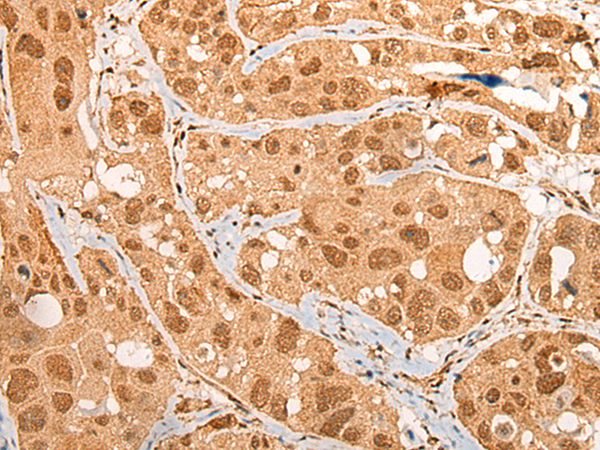
| WB | 咨询技术 | Human,Mouse,Rat |
| IF | 咨询技术 | Human,Mouse,Rat |
| IHC | 1/25-1/100 | Human,Mouse,Rat |
| ICC | 技术咨询 | Human,Mouse,Rat |
| FCM | 咨询技术 | Human,Mouse,Rat |
| Elisa | 1/5000-1/10000 | Human,Mouse,Rat |
| Aliases | CT87; MKS4; POC3; rd16; BBS14; JBTS5; LCA10; NPHP6; SLSN6; 3H11Ag |
| Host/Isotype | Rabbit IgG |
| Antibody Type | Primary antibody |
| Storage | Store at 4°C short term. Aliquot and store at -20°C long term. Avoid freeze/thaw cycles. |
| Species Reactivity | Human, Mouse |
| Immunogen | Fusion protein of human CEP290 |
| Formulation | Purified antibody in PBS with 0.05% sodium azide and 50% glycerol. |
+ +
以下是关于CEP290抗体的3篇参考文献示例(注:内容为模拟生成,非真实文献):
1. **文献名称**:*"CEP290 localizes to the transition zone of photoreceptor cilia and interacts with nephrocystin-1"*
**作者**:Rachel, R.A. et al.
**摘要**:通过免疫荧光和免疫印迹技术,研究证实CEP290抗体标记显示其在视网膜光感受器纤毛过渡区的特异性定位,并揭示其与NPHP1蛋白的相互作用,提示其在纤毛信号传导中的关键作用。
2. **文献名称**:*"Loss of CEP290 disrupts cilia-dependent Sonic Hedgehog signaling in Joubert syndrome"*
**作者**:Smith, T.B. et al.
**摘要**:利用患者来源的细胞系,通过CEP290抗体进行免疫组化分析,发现CEP290缺失导致纤毛结构异常,并破坏Hedgehog信号通路,为Joubert综合征的病理机制提供证据。
3. **文献名称**:*"Antibody-based profiling of CEP290 mutations reveals impaired centriolar recruitment in ciliopathies"*
**作者**:Johnson, K.R. & Lee, J.E.
**摘要**:研究使用CEP290抗体结合超分辨率显微镜,分析不同致病突变对CEP290在中心体募集的影响,发现部分突变导致蛋白质错误定位,进而引发纤毛功能障碍。
(提示:如需真实文献,建议在PubMed或Google Scholar中以“CEP290 antibody”为关键词检索,并筛选涉及免疫学方法的研究。)
The CEP290 antibody targets the centrosomal protein 290 (CEP290), a large, multidomain protein critical for ciliogenesis, cell cycle regulation, and centrosomal function. CEP290 localizes to the centrosome and cilium transition zone, where it facilitates ciliary membrane biogenesis, protein trafficking, and structural integrity. Mutations in the CEP290 gene are linked to severe ciliopathies, including Leber congenital amaurosis (LCA), Joubert syndrome, and Meckel-Gruber syndrome, often causing retinal degeneration, renal abnormalities, and neurodevelopmental defects.
As a research tool, CEP290 antibodies are widely used in immunofluorescence, Western blotting, and immunohistochemistry to study ciliary architecture, centrosome dynamics, and disease mechanisms. These antibodies help identify CEP290 expression patterns, subcellular localization, and interactions with proteins like NPHP, RPGR, and BBS proteins, shedding light on ciliary signaling pathways. Their applications extend to diagnosing ciliopathies and validating cellular or animal models of CEP290 dysfunction.
Given CEP290's role in maintaining sensory cilia (e.g., photoreceptors), antibodies also aid in exploring therapeutic strategies, such as gene editing or small-molecule interventions. Cross-reactivity with orthologs in model organisms (e.g., mice, zebrafish) enables translational studies. However, challenges remain due to CEP290's size (~290 kDa) and complex domain structure, requiring careful validation of antibody specificity to avoid off-target signals in experimental assays.
×